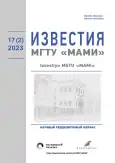Development of operation algorithm of electric drive of an electric vehicle in urban cycle
- Authors: Klimov E.M.1, Fironov A.M.1, Maleev R.A.1, Zuev S.M.2
-
Affiliations:
- Moscow Polytechnic University
- MIREA-Russian Technological University
- Issue: Vol 17, No 2 (2023)
- Pages: 137-146
- Section: Combined power plants
- URL: https://journals.rcsi.science/2074-0530/article/view/253970
- DOI: https://doi.org/10.17816/2074-0530-321355
- ID: 253970
Cite item
Full Text
Abstract
BACKGROUND: Increasing energy efficiency of an electric vehicle is one of the most relevant issues at the current state of transport development. It is known that chemical current sources used in traction electric drive of vehicles have low specific power, low efficiency and high cost that makes the electric transport development difficult.
AIMS: Making the choice of strategy of manufacturing of electric vehicle with batteries.
METHODS: The mathematical models of various vehicle driving cycles, such as: the UNECE Regulation 83 urban cycle, NEDC, WLTC, JC08, EPA HWEET were used in the study that made possible to confirm adequacy of the developed structural model of the electric drive.
RESULTS: The structural layout of the traction electric drive of an electric vehicle with combined energy source has been developed; the algorithm of its operation in the urban driving cycle has been defined. Electric transport efficiency was assessed during the study. The analysis showed that vehicles with solely chemical on-board energy sources do not have any prospects due to unsatisfactory technical properties and consumer attributes. Review of capacitors was performed in order to define the possibility of using them as energy source for next-generation vehicles. The study revealed sufficient advantages of capacitors in many respects. Analysis of vehicle motion in urban cycle was performed in order to develop the optimal design. The electric drive layout with a lithium-ion traction battery as the main energy source and a capacitor as the additional energy source was chosen.
CONCLUSIONS: This solution makes it possible to develop the electric drive with optimal mass and dimensional parameters, to increase service life of energy storage and mileage without recharging of a vehicle. In addition, the combination of two electric energy accumulators and the developed algorithm of their operation makes it possible to achieve high efficiency of energy transferring.
Full Text
##article.viewOnOriginalSite##About the authors
Egor M. Klimov
Moscow Polytechnic University
Author for correspondence.
Email: egormixalich71@mail.ru
ORCID iD: 0009-0004-9739-0267
SPIN-code: 5642-7180
Engineer of the “Electrical Equipment and Industrial Electronics Department
Russian Federation, 38 Bolshaya Semyonovskaya street, 107023 MoscowAnatoly M. Fironov
Moscow Polytechnic University
Email: a.m.fironov@mospolytech.ru
ORCID iD: 0000-0003-2683-9958
SPIN-code: 8824-5702
Scopus Author ID: 462035
Associate Professor, Cand. Sci. (Tech.), Associate Professor of the Land Vehicles Department
Russian Federation, 38 Bolshaya Semyonovskaya street, 107023 MoscowRuslan A. Maleev
Moscow Polytechnic University
Email: 19rusmal@gmail.com
ORCID iD: 0000-0003-3430-6406
SPIN-code: 7801-3294
Associate Professor, Cand. Sci. (Tech.), Professor of the Electrical Equipment and Industrial Electronics Department
Russian Federation, 38 Bolshaya Semyonovskaya street, 107023 MoscowSergey M. Zuev
MIREA-Russian Technological University
Email: sergei_zuev@mail.ru
ORCID iD: 0000-0001-7033-1882
SPIN-code: 6602-6618
Associate Professor, Cand. Sci. (Physics and Mathematics), Head of the Electrical Equipment and Industrial Electronics Department
Russian Federation, 78, Vernadsky Avenue., 119454 MoscowReferences
- IEA – International Energy Agency. Latest news, commentaries and reports. Accessed: 14.03.2023. Available from: https://www.iea.org/
- Ivanov SA. Issledovanie ispolzovaniya superkondensatorov v kombinirovannykh energoustanovkakh transportnykh sredstv [dissirtation] Moscow; 2003. (In Russ).
- Gusakov NV, Zverev IN, Karunin AL, et al. Car design. Chassis. Moscow: MAMI; 2000.
- Hortov VP. “Fiery motor” with an electric capacitor, or what will save the earth’s oxygen. Tekhnika – molodezhi. 2000;4:34–35. (in Russ.)
- Varypaev VN, Dasoyan MA, Nikolsky VA. Chemical current sources: textbook for chemical-technical specialist. Moscow: Vysshaya shkola; 1990. (In Russ).
- Polyakov NA. Sistema elektrostarternogo puska transportnykh sredstv s primeneniem kombinirovannogo istochnika elektricheskoy energii [dissertation] Moscow; 2005. (In Russ).
- Lavrikov AA, Maleev RA, Zuev SM, et al. Mathematical modeling of an adapter for equalizing battery voltages. Vol. 1. Moscow: MGTU «MAMI». 2019;3(41):57–66. (In Russ).
- Zackheim L.N. Electrolytic Capacitors. Moscow, Leningrad: Gosudarstvennoe energeticheskoe izdatelstvo; 1954.
- GOST R 41.83-99. (Pravila EEK OON № 83). Edinoobraznye predpisaniya, kasayushchiesya ofitsialnogo utverzhdeniya transportnykh sredstv v otnoshenii vybrosov zagryaznyayushchikh veshchestv v zavisimosti ot topliva, neobkhodimogo dlya dvigateley. Dobavlenie 82. Peresmotr 3. (In Russ). Available from: https://meganorm.ru/Data2/1/4294847/4294847005.htm
- GOST R EN 1986-1-2011. Avtomobili s elektricheskoy tyagoy. Izmerenie energeticheskikh kharakteristik. Ch. 1. Elektromobili. (In Russ). Available from: https://files.stroyinf.ru/Data/512/51232.pdf
- GOST R 59078-2020. Elektromobili i avtomobilnye transportnye sredstva s kombinirovannymi energoustanovkami. Klassifikatsiya. (In Russ). Available from: https://files.stroyinf.ru/Data/752/75225.pdf
Supplementary files















